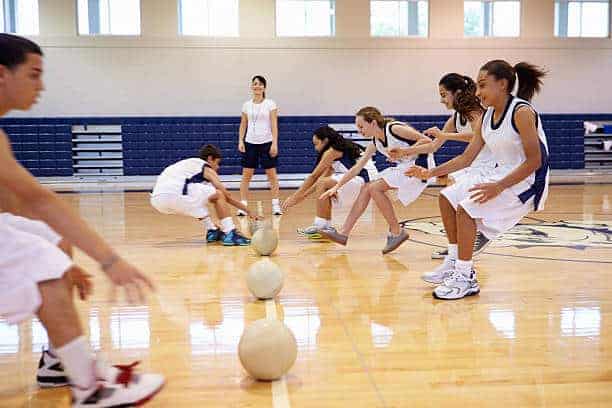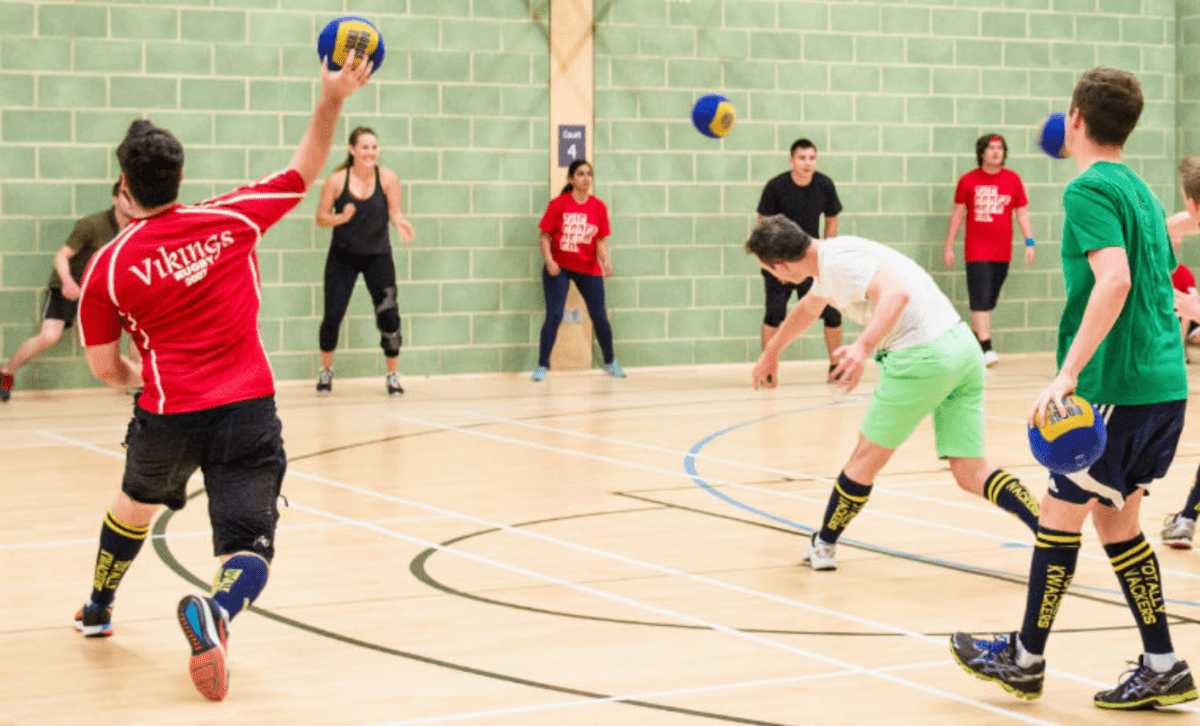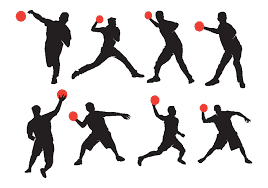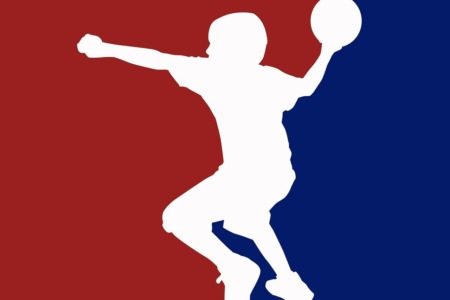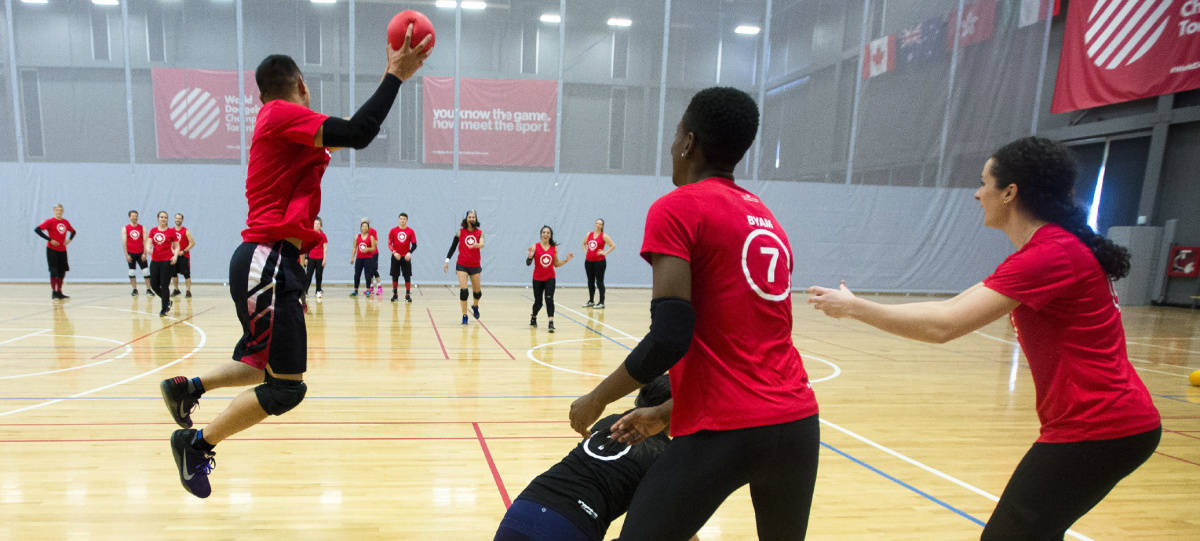In this article, dodgeball is discussed, an alternative sport that can be treated as educational content in Physical Education, both in the final years of primary education and in secondary education.
It explains how to play it, what its characteristics are, and how it can be implemented through a practical proposal.
What is dodgeball and how is it played?
It is an alternative sport born in the United States in the 20th century. From this, other more well-known sports in Spain derive, such as the sport called Dachball, born in Aragón, or also known as prisoner ball as a game.
Despite presenting similar characteristics, they differ in several aspects which will be detailed later.
Dodgeball is a collaboration-opposition sport, with a divided court. The objective is to eliminate, by hitting with the balls, the players of the opposing team before they achieve the same.
It is played with 6 balls, the sidelines of the court, as well as the end lines, can also eliminate players. The match has two halves, each lasting fifteen minutes.
Each game within each half lasts a maximum of three minutes; each game won counts 2 points and a tie 1 point. The team with the most points at the end of the time wins.
What are its characteristics?
While datchball has 3 balls, features mixed teams, and a more educational context-adapted regulation, dodgeball has 6 balls and features more competitive rules.
In dodgeball, two teams of 6 players each play, as mentioned, with 6 balls, which can be thrown at any part of the body except the head.
The dodgeball playing field is a rectangle measuring 18 meters long by 9 meters wide. It is a divided court sport, so each team must remain on its half of the field.
The main objective of dodgeball is to throw the balls at the opponents to hit them and thus eliminate them from the field.
In less than 3 minutes that each dodgeball game lasts, one of the two teams must be able to eliminate all the opposing players or aim to eliminate more players than those eliminated in their own team. If the same players remain in both teams during a game, it will add one point per team, resulting in a tie.
To start each dodgeball game, players from both teams will be placed behind the end line of their own field. At the same time, the balls will be placed along the center line.
When the referee gives the signal, the teams run for the balls. If several players grab the ball at the same time, the start is repeated.
Descubre la importancia de trabajar con deportes alternativos en Educación Física.
Veremos paso a paso, el auge en la última década de este tipo de deportes en el ámbito de la educación física, además se van a presentar dos propuestas prácticas para su desarrollo.
What skills does dodgeball develop?
Dodgeball develops a multitude of skills:
- throwing
- catching
- dodging
- jumping
Dodgeball requires hand-eye coordination, time management, and reaction speed. It also works on cardiovascular endurance while promoting the use of strategies and cooperation.
Rules of dodgeball in Physical Education
Below are some of the fundamental rules for practicing dodgeball:
- You can throw at any part of the body that is not above the shoulders.
- Players are eliminated when the ball hits a player and then falls to the ground, also when it is caught and lost by touching the ground.
- Two players can also be eliminated at the same time if the ball hits one and then bounces and hits a teammate before falling and touching the ground.
- If a player leaves the playing area or crosses the center line of the field that separates both teams, they are eliminated.
- Players who are eliminated must leave the field and until they return to participate, they perform the role of collecting balls that go out of the field.
- To save an eliminated player, you must catch the ball in the air when it is thrown by a player from the opposing team. The player who comes back to life is the one who died first, thus maintaining the order of play constantly.
- Once the ball is caught, the player who possesses it cannot move, only throw or pass to a teammate.
- Throws can only be made with the hands, the ball cannot be thrown with the feet.
- The maximum time a player can hold possession of a ball is 5 seconds. Likewise, while maintaining this possession, the ball can serve as a shield to protect against hits from another ball.
Considering the rules and regulations of the sport, it is worth noting that these can be adapted within the school context, taking into account the characteristics of the students being worked with. Some of the aspects that can be modified are the following (1):
- Mobiles and implements: increasing or decreasing the number of them to make the task or game more difficult or easier.
- Goals: instead of eliminating by touching the player and having them leave the field, adapt it and play with several lives that can be lost.
- Playing field: expand or reduce the space as required.
- Players: introduce players as wildcards or decrease or increase the number of players practicing in each team.
- Time: Decrease the time of each part during the actual game, or on the contrary, increase it. As well as modify the time of the games, adapting it to the capacity and condition of the students and the time available.
- Regulation: modify the rules in the aspects deemed appropriate.
- Sports skills, for example, instead of not being able to move with the ball in hand, one or two steps can be taken. Another alternative would be that players cannot run, only move by walking, etc.
- Tactical thinking: facilitating strategies so they can develop and put them into practice.
Additionally, the work of other roles besides the player role can be considered, as 12 people play simultaneously, but in a single PE class, there will be more students, so more figures should be introduced for them to have constant active participation.
For example, collecting balls that go out of the field, as wildcards, as team coaches who promote the use of attack and defense strategies, and as observers and referees.
It is a sport that teaches values such as sportsmanship, teamwork, respect, emotional control, etc., therefore, a good tool and content within the school system.
This sport, played or practiced correctly, helps students control aggression, as well as relieve frustration (2).
Practical proposal of dodgeball in Physical Education
There are many models and styles that favor appropriate methodologies to implement the different contents to be worked on in the PE subject.
In this case, the Sport Education model is proposed to develop a practical proposal through a didactic unit of dodgeball of 10 sessions, for 3rd-year ESO students.
Likewise, the proposed number of sessions can be increased according to the calendar and organization, considering the importance of conducting at least 10 sessions if this model is followed so that all its phases can be developed (3).
Prior to the proposal, it is important to know the students to adapt it as much as possible to their characteristics and thus, be able to offer meaningful learning that promotes the education and integral development of the students.
Both in the motor and cognitive plane as well as at the emotional level (4) through the treatment of activities that favor interpersonal relationships, cooperative work, self-knowledge, and self-improvement.
To develop the unit, it starts with a presentation session, where the objectives, content, evaluation, etc. are explained, and a sample video of the dodgeball sport is shown to capture the students’ attention and motivation.
In sessions 2, 3, and 4, the directed practice phase is carried out, in which the teacher controls and organizes the activities without giving the students too much autonomy.
In it, technical aspects of the sport are practiced, throws, receptions, aim, and regulations, etc.
In the same, little by little, it seeks to approach more autonomous styles with guided discovery activities and problem-solving. Some examples of dodgeball activities could be the following:
- 4-person rondo with one person in the middle trying to steal the ball.
- Variants of the same: increasing the people stealing, the people passing the ball, and including more balls.
- 3 x 3 and 4 x 4 situations where they must use different types of throws, dodge ball movements, and receptions of the same.
In sessions 5, 6, and 7, a more autonomous dodgeball practice is proposed where the student themselves propose solutions to the activities and are more involved at a cognitive level. In this, games and strategy activities of defense and attack by groups are proposed:
- 4×4 where attack and defense strategies that the students have developed are implemented. First focusing on defense and then on attack.
- The same, increasing to 5×5
- Modify the number of balls and introduce 1, 3, and 5
- Modify the players by introducing wildcards along the sidelines
The last three sessions focus on formal competition and the final event.
- During session 8 and 9, a tournament is held introducing the real game, with 6 players per team and 6 balls. During session 8, it is practiced without competition, and the teams and the distribution and organization of the tournament are organized.
- During session 9, the tournament is held. 2 teams play, and the third team is in charge of refereeing, collecting balls, and photographing the tournament. These roles change so that everyone practices all.
- In the last session, prizes are awarded, giving prizes for the cleanest play, the best implementation of strategies, the winner of the matches, etc., without leaving any student without a prize. Likewise, throughout the unit, photos and videos of the unit’s development are taken to show a memory video of it during this last session. As the end of the unit, a reflection is proposed seeking the students’ contributions on how to practice dodgeball outside the school environment, what difficulties and facilities it presents, and what this unit has contributed to them in terms of new learning and practice resources.
Conclusions
Dodgeball is a sport with a multitude of resources, which moves away from conventional sports, providing motivation and innovation for practice in the subject of physical education.
Furthermore, as seen, it presents characteristics with great possibilities of adaptation to the students being worked with, making it a content to consider throughout all courses that complement more traditional sports or proposals, easily capturing the students’ attention.
Bibliography
- Giménez, A. M. (2010). The mobile target sports games: Proposal for categorization and implementation from a comprehensive, inclusive, and creative approach. Challenges: new trends in physical education, sport, and recreation, (18), 41-46. Retrieved from: https://dialnet.unirioja.es/servlet/articulo?codigo=5410089
- Goodwin, S., Kahan, D., Murray, S. R., & Docheff, D. (2001). Is there a place for dodgeball in physical education?. Journal of Physical Education, Recreation & Dance, 72(4), 17. Retrieved from: https://search.proquest.com/docview/215762258/fulltextPDF/F647BD41CD994558PQ/1?accountid=14795
- Gutiérrez Díaz del Campo, D., García López, L. M., Chaparro Jilete, R., & Fernández Sánchez, A. J. (2014). Application of the Sport Education model in second grade of Primary Education: perceptions of students and teachers. Journal of Sport Psychology, 14(2), 131-144. Retrieved from: http://scielo.isciii.es/pdf/cpd/v14n2/ciencias_deporte5.pdf
- Muñoz, V. A., Roque, J. I. A., & Lucas, J. L. Y. (2017). Playing positively: gender and emotions in physical education. Notes. Physical education and sports, 3(129), 51-63. Retrieved online.
{
“@context”: “https://schema.org”,
“@type”: “FAQPage”,
“mainEntity”: [
{
“@type”: “Question”,
“name”: “What is dodgeball?”,
“acceptedAnswer”: {
“@type”: “Answer”,
“text”: “Dodgeball is a team game where players try to eliminate their opponents by hitting them with rubber balls.”
}
},
{
“@type”: “Question”,
“name”: “How many players are needed to play dodgeball?”,
“acceptedAnswer”: {
“@type”: “Answer”,
“text”: “To play dodgeball, at least six players are needed, three on each team.”
}
},
{
“@type”: “Question”,
“name”:”What are the basic rules of dodgeball?”,
“acceptedAnswer”:{
“@type”:”Answer”,
“text”:”The basic rules of dodgeball include not stepping out of the field boundaries, not throwing the ball over the center line, and not catching a ball thrown by the opponent.”
}
},
{
“@type”:”Question”,
“name”:”How do you win a game of dodgeball?”,
“acceptedAnswer”:{
“@type”:”Answer”,
“text”:”A game of dodgeball can be won by eliminating all players of the opposing team or having more players on the field at the end of the allotted time.”
}
},
{
“@type”:”Question”,
“name”:”What are the benefits of playing dodgeball?”,
“acceptedAnswer”:{
“@type”:”Answer”,
“text”:”Playing dodgeball can help improve coordination, balance, agility, and physical endurance.”
}
},
{
“@type”:”Question”,
“name”:”Are there different variants of dodgeball?”,
“acceptedAnswer”:{
“@type”:”Answer”,
“text”:”Yes, there are different variants of dodgeball. Some of the most popular include traditional dodgeball, soft ball dodgeball, and inflatable dodgeball.”
}
},
{
“@type”:”Question”,
“name”:”Is dodgeball a safe sport?”,
“acceptedAnswer”:{
“@type”:”Answer”,
“text”:”Dodgeball can be safe if played with caution and following the rules. It is important to use appropriate protective equipment and establish clear boundaries to avoid injuries.”
}
},
{
“@type”: “Question”,
“name”: “Where can I find places to play dodgeball?”,
“acceptedAnswer”: {
“@type”: “Answer”,
“text”: “You can find places to play dodgeball at recreational centers, gyms, or local sports facilities.”
}
}
]
}
